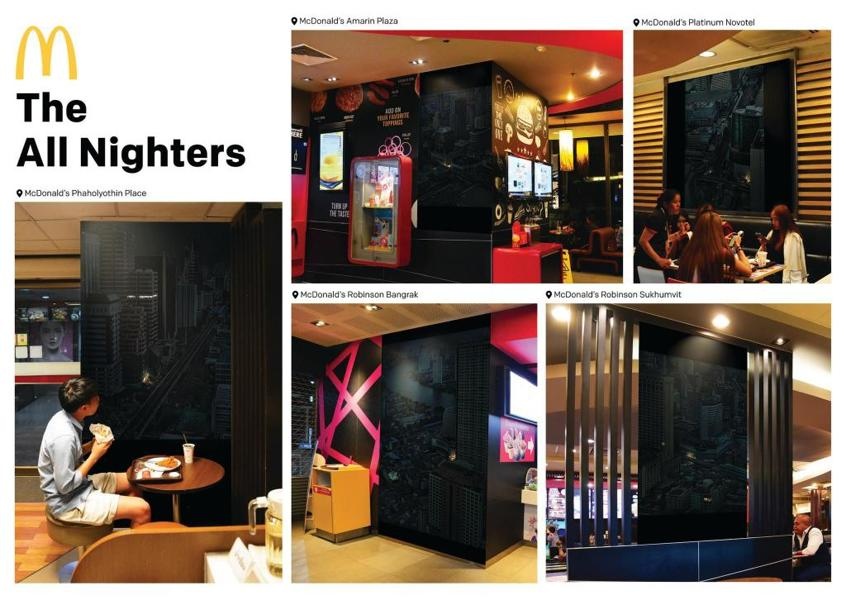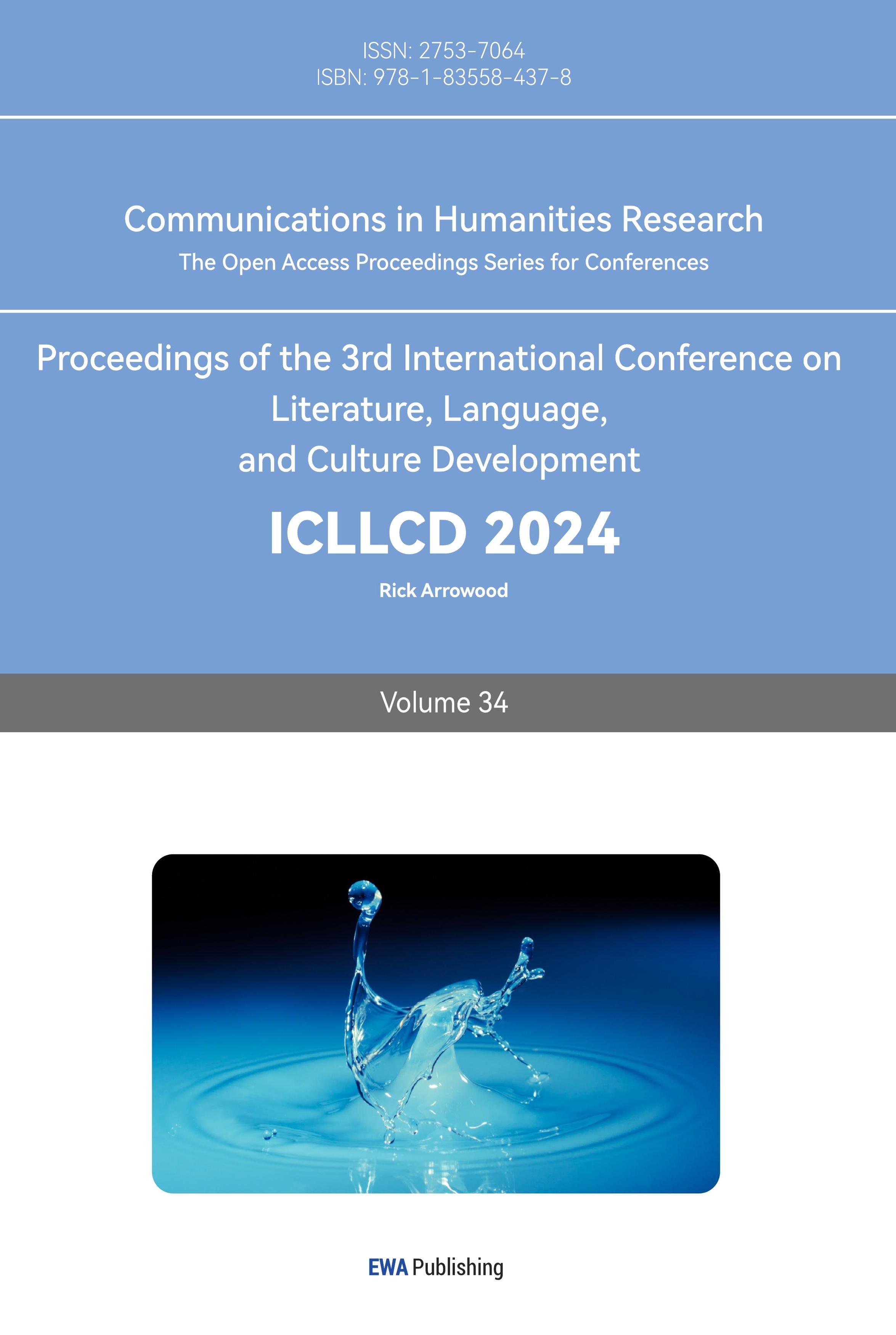1. Introduction
The media industries are dynamic and changing; the economic role of media production is growing. More and more people analyze the information that various media convey to society and the public through the theory of visual communication. These various media texts come from different advertisements, videos, films, photographs, news, and even some logos from products. Photographs and video arrangement are a significant part of media communication, and what we see in a video or images comes from a number of approaches from traditional semiotics and linguistics. [1]. According to the semiotics, symbol and the combination of sign and expression of surface common to the audience and the content side of the means of information transmission symbol. This essay will collect and analyze a cohesive set of images from a set of print advertising images from McDonald's. Analysis of its images can further explore how symbols express information.
Excellent advertisements are always deeply rooted in people's hearts and minds. McDonald's advertising is famous all over the world. It is full of factors such as wisdom, creativity, and culture. It uses much expertise in many advertising ideas. It should discuss a more detailed descriptive and interpretive analysis of the set of images using the analytical steps of the social semiotic framework. The essence of advertising creativity is to imagine and make creative objects, combining the beauty of reality and art. The American Advertising Association for Advertising means that advertising is a paid mass communication, and its ultimate purpose is to transmit intelligence, change people's attitudes towards advertising goods, and induce their actions to benefit advertisers.
McDonald's restaurant is a large chain fast food group with about 30,000 branches worldwide, mainly selling hamburgers, french fries, fried chicken, soft drinks, ice products, salads, and fruits. McDonald's restaurants are located in more than 100 countries on six continents. [2]. McDonald's represents an American lifestyle in many countries. As a fast food, McDonald's is famous all over the world. In addition to the uniqueness of its products and the fast, clean, and pleasant environment it provides, its advertising has played a vital role. Analyze their advertisements' specific images, slogans, and star strategies to see how they work.
People usually think of a golden M logo on a red background for McDonald's, which is McDonald's universal "symbol mark." Through the McDonald's logo, people can quickly think of the food produced by McDonald's, such as hamburgers, signatures, crispy cylinders, and zephyr meals. The second meaning refers to the McDonald's brand symbolization process following this rule. [3]. McDonald's refers to a new, popular, international, and fashionable way of life, an international concept.
McDonald's advertising images convey ideas through images, slogans, spokespersons, and celebrities. McDonald's leads the global fast food industry with its advanced awareness. For example, McDonald's began operating 24 hours at the end of the last century, using degradable paper bags as takeaway packaging, and the time-limited items, such as hamburgers, chips, and pies, that are sold are disposed of over time. Among them, in 2017, McDonald's launched a 24-hour advertisement. McDonald's in different countries created different advertising images and conveyed different connotations. To a certain extent, McDonald's, open 24 hours, has become another habitat for people who have yet to return home late at night. After a short period, they replenish their vitality and re-enter the turbulent flow of people to fight for their own happy lives.
2. Visual images of McDonald's advertisements
McDonald's Thailand 24-hour late-night theme poster with the theme "The world has not abandoned you," McDonald's waiting for you overnight. [4]. According to the images, McDonald's golden arches shone bright at night. They change from a sign to a lighthouse, saying, "The world has not abandoned you; there will always be a place for you, and you are not alone." McDonald's no longer focused on itself but paid attention to the night workers who were most easily overlooked and stuck to their posts, expressing a strong "guardian" feeling. The 24-hour business advertisement has reached a spiritual level.
In this group of images and ideas, there are two places in the night city with bright light, one of which is the McDonald's restaurant. In addition to workers, people who stay up late to read books, play games, parties, and takeaways are also added. Moreover, these "night walkers" are no longer invisible. McDonald's used the "M" shaped light to illuminate the darkness and guarded every nightwalker. So, how does this set of advertisements set the night scene? What symbols are used to express, and what are the hidden meanings? How to target specific occupational groups among consumers to resonate? What are the similarities and differences between these images?

Figure 1: McDonald's Thailand 24-hour late night theme poster.
3. Three analytical steps of the social semiotic
About understanding images, Roland Barthes said that "the viewer of the image receives at the same time the perceptual message and the cultural message" [5]. McDonald's of Thailand took 6 images to compose this set of advertisements. The scenes in the images all take place in Thai cities, and these photos indeed show the scene of Bangkok city at night. The yellow logo on the screen and another city light spot are the most striking signs, representing the restaurant on one side and the crowd on the other. The black and grey background creates an excellent late-night atmosphere, using actual lenses and meticulous photography to portray a corner of the city. The McDonald's restaurant, which is still open, has also been highlighted.
Moreover, "The way we see things is affected by what we know or believe" [6]. So it needs to consider the relationship between the signifier and the signified. Semiotics is concerned with everything that can be taken as a sign. A sign can be taken as significantly substituting for something else. This set of images used five scenes: The meeting, Rooftop soccer, Morning shift, Designer, and Graffiti. The following images are:

Figure 2: The meeting.

Figure 3: Rooftop soccer.

Figure 4: Morning shift.

Figure 5: Designer.

Figure 6: Graffiti.
4. The representational meaning of these images
The image depicts a scene of the city at night; the dark city and the bright McDonald's logo are unchanged, and the different nightlife scenes are changed. These scenes represent different groups of people with different stories behind them.
First of all, the focus is on the bright McDonald's restaurant, which clearly shows the purpose of this advertisement: the 24-hour open business. McDonald's image is composed of various symbols, creating a mythology. The "myth" mentioned here differs from the meaning in the Chinese dictionary. However, it is more common in the words of Roland Bart, the academic of semiotics, rhetoric, and cultural studies. [7]. Myth is a kind of speech, a semiotic system. It mainly includes the signifier, signified, and meaning of the sign. The signifier is the material form of the sign, the image of the sign, which our senses can perceive. What is meant by the indicated component is meaning. The meaning can be called "meaning action" or "meaning mode," which refers to the relationship between the signifier and referential. It can be either a relationship in the formation process or the result of such a relationship. The myth comes from the two meanings of the sign. The first is the relationship between the signifier and the signified and between the sign and the external things it refers to. The second time is a kind of cultural meaning, sometimes produced meaning that has nothing to do with the first-level meaning itself. The Swiss linguist Saussure also proposed that the signifier and the referential are a pair of categories of structural linguistics. [8]. In Saussure's structural linguistics, "meaning means, "signifier," and "referential" are three closely related concepts. The meaning refers to the relationship between the following two: on the one hand, is a language sign representing a specific thing or abstract concept; on the other hand, is a concrete thing or abstract concept represented by a language sign. He refers to the linguistic signs used to represent specific things or abstract concepts in the meaning of action as signifiers and to the specific things or abstract concepts represented by language signs as the referent, which refers to the meaning that the meaning means to express. The image appears repeatedly and emphasizes the golden M logo, McDonald's universal symbol mark. Through the McDonald's logo, people can quickly think of the food produced by McDonald's: hamburgers, strips, crispy cylinders, and zephyr meals, the first process of myth operation, which is the first meaning of the symbol. The second meaning refers to the branding process of McDonald's brand symbol following this rule. McDonald's refers to a warm, new, popular, and fashionable lifestyle. The warm logo allows consumers to feel a warm, intimate, and caring comfortable experience.
Secondly, the image includes a group of people performing different actions. Some of the actions are performed by the different people in the five images and objects portrayed in the images. In the first image of the meeting, the only person who appears is working or meeting in a high-rise office building. Only this floor is bright in this whole building, which means it is very late. Time average or ordinary personnel have already left after work, showing that nighttime is a unique and challenging situation. It can be seen that there is not only one person here but a group of people. Although it cannot tell whether they are men or women, their age and appearance, they can see the faint, busy figure through this image. Let the viewer immediately think of the concept of the "office worker." The setting of late-night overtime is reminiscent of hard work, heavy staff, overtime, hunger, fatigue, and anxiety. Only this light is in the darkness, and it even makes people feel bleak and lonely. However, it shows another light: McDonald's restaurant, which again implies that one works overtime alone and is tired and sleepy. However, one is not fighting alone, but also accompanied by McDonald's service.
These visual resources form a harmonious atmosphere, bringing the person viewing the picture into a specific mood and environment. It is reminiscent of being a member of many pictures and being in the same time and space at a particular moment. People who work late at night may be themselves, people who exercise at night may also be themselves, and there may be cases where they go out to work before dawn or work overtime until late at night in a meeting. In this scenario, the only restaurant nearby is McDonald's. The scene and McDonald's are the only places in the world with lights.
5. The interactive meaning of these images
The image interacts with the viewer through various aspects. The first task of the advertising picture is to reach the user, arouse people's attention, guide people to pay attention to the advertising content itself, and finally convert the deal and let the reader take action. The producer of the message uses the signal to encode it, and then it is decoded by the listener, who then reproduces the message. [9]. Regarding image advertising, this link mainly relies on visual images to arouse people's attention. There are creative methods of contrast and exaggeration, as well as well-designed layout and color matching to express the screen to win users' valuable attention time.
First, the visual impact is shown in the picture, which refers to not only some intense colors, exaggerated visual effects, or explosive texts but also some style design performance impact, plate composition impact, element performance impact, and innovative concepts and the uniqueness brought. [10]. There is a large area of the urban landscape background, which looks at the entire city from an overhead perspective, allowing the audience to see all the elements contained in the picture as a bystander. LikeLike watching a movie, the wide-angle visual effect the wide-angle visual effect can ultimately tell the story of this late night.
It is the simplicity of the picture. The picture's most important function is to inform people about the products to be promoted and make people interested in reading. The attractiveness of the advertisement is inversely proportional to the amount of information on the picture. These advertising pictures of McDonald's distinguish the background and the key points in simple colors, making the complex urban landscape simple. The vast frames make the viewer feel like they are in it. The more complex the image, the more cluttered the viewer will feel. Good advertising should have a simple and robust guiding effect; the rest should be left to the product itself. Finally, the picture shows a deep affinity. Although the contact distance felt in the picture is relatively long, the concentrated attention has brought the viewer closer. The characters and stories in these scenes may have their figures mainly due to the accurate positioning of McDonald's 24-hour service. According to his user group, people who need restaurants in the middle of the night highlight their positioning, analyze their common identity and needs, and determine their needs according to their needs and product characteristics. The audience recognizes the core content of the advertisement.
6. The compositional meaning of these images
In these images, the highlighted objects and the M-type lights of McDonald's restaurants are kept at a relatively close distance, which implies that viewers, McDonald's restaurants, regardless of the size of the city, operate many chain stores. Moreover, close to consumers, it is easy to buy. Even if the city is asleep, McDonald's lights will be on the corner. This way of performance makes it easy for consumers to think that such a store is close to them. The color largely determines the style of the picture. [11]. The black background highlights a lonely atmosphere and displays the feeling of late night. The point of color is McDonald's; what kind of color can convey what kind of feelings? Mainly yellow light and a little red, the overall warm color effect brings a warm and safe feeling. In addition, they are all warm-color lights, which have the effect of echoing each other, and there are some connections between them. The contrast between warm and cold colors, the contrast between black and color, and the contrast between relaxed and lively psychologically impact the viewer. The picture is not a traditional layout, it is a messy city.
However, it is easy to find that when watchinging it, every house, every street, prominent point, and McDonald's restaurant are scientifically arranged in the order of visual movement. Highlights order or order in chaos. Modern information flows are significant, and viewers are bombarded with countless pictures daily. Some consumers tend to have creative works. This set of McDonald's images, with exceptional creativity and ideas, uniquely expresses the story of late-night business. When the audience sees it, because they are free, they can understand it to digest the creativity on the screen, delivering more information and value.
7. Critical analysis
Various situations that may appear in people's daily lives repeatedly appear in the images to narrow the distance to the audience and make the connection between them. The response may be related to social practice, political awareness, or other measurable consequences. However, the communication between the maker and the audience is complete and adequate to reproduce this information. How new audience members use previous cultural experiences to find the language that expresses their first impressions of unfamiliar art activities may be valuable for targeted marketing and to make art activities easier for new participants to use. [12]. The community nowadays has a moderate audience but has moved into an active audience. [13]. However, a large number of consumers have developed eye inertia. As long as the picture is beautiful enough to make the eye comfortable, there is no extra energy to understand creativity. "The tensions and harmonies between the signals from the various encoders could build a picture of what the audience needed to decode, even though the encoding process never determined the audience's interpretation." [14]. However, the images also show some unhealthy lifestyles. When the night falls, the 24-hour business expressed in the image, with the sacrifice of some people's rest time as a means, highlights the unhealthy way of overwork. Some people's self-exploitation at work use this lifestyle to connect with people who stay up late at night. Lifestyle le has entered our lives as a popular text. [15]. Everyone is pursuing the lifestyle they want. However, do we recognize that these lifestyles are unequal, and many factors affect lifestyle inequality? The role of advertising pictures in reshaping the inequality of lifestyle. Does the implicit meaning of advertising reduce the inequality of people's lifestyles or increase the inequality between them?
8. Conclusion
With the continuous advancement of the information society, the distance between people in modern society is gradually shortened, and graphics are used as tools for humans to exchange ideas. Analyzing the meaning of the symbols in the image can make the information transmission of graphic design more scientific and accurate, and the expression techniques are more, which is applied to the field of art creation and graphic design. Man is an animal of symbols [16]. Moreover, the means of people's spiritual communication is a complete system composed of a series of perceptible symbol units. Graphic design itself is a symbolic image in visual space design, and is a more direct and accurate communication medium in the visual communication process. It plays a vital role in communicating culture and information between people.
In graphic design, using semiotics influences the expression of design thinking. Because of its existence, the image design conveys information more scientifically and accurately, and the expression techniques are more colorful. With the rapid development of graphic languages, how to deepen the semiotic meaning of graphic design has become an essential topic for us. Semiotics is the study of systematic symbols, and its purpose is to establish widely applicable communication rules. The symbol refers to a form of expression in information dissemination, and the reference refers to the specific dissemination content of the symbol.
Simply put, symbols in semiotics are systematic symbols that people use to convey or convey meaning. As a non-verbal symbol, the symbol in graphic design has many similarities with language symbols. How to regard the elements and primary means of graphic design as symbols, through the processing and integration of these elements, to express emotions? Therefore, the value of symbols should be reflected in information dissemination and communication. In the course of its continuous development, semiotics is also increasingly used as a method in the field of art creation and graphic design.
References
[1]. Hansen, A. and Machin, D. (2019). Analysing photographs and video. In media and communication research methods. London: Red Globe Press.
[2]. Shi, G. (2020) Appreciation of McDonald's advertising case. [Online]. [Accessed 29 March 2020]. Available from: https://wenku.baidu.com/view/0f10c325aaea998fcc220ed6.html
[3]. Barthes, R. (1973). Mythologies. London: Paladin.
[4]. Qi, Y (2018). The world did not abandon you, McDonald's Thailand pierced tears late at night [Online]. [Accessed 2 March 2018]. Available from: https://www.digitaling.com/projects/33599.html
[5]. Barthes, R. (1964/1977). “Rhetoric of the image” (pp. 32-51). In Image, music, text. New York: Hill and Wang.
[6]. Berger, J. (1977). Ways of seeing. London: Penguin.
[7]. Hansen, A. and Machin, D. (2019). Analysing photographs and video. In media and communication research methods. London: Red Globe Press.
[8]. Saussure, F., Bally, C., Sechehaye, A., Riedlinger, A., & Harris, R. (1983). Course in general linguistics . London: Duckworth.
[9]. Hall,S. (1996) “Encoding/Decoding,” in Stuart Hall, Dorothy Hobson, Andrew Lowe, and Paul Willis, eds., Culture, Media, Language: Working Papers in Cultural Studies, 1972–79 (London: Routledge, 1996), 128–38.
[10]. Dong, W (2011). What are the main points of the design of a print advertisement? [Online]. [Accessed 9 December 2011]. Available from: https://www.zhihu.com/question/19913303
[11]. Kobayashi, S. (1991). Color image scale . Tokyo ;: Kosdansha International.
[12]. Pitts, S., & Gross, J. (2017). “Audience exchange”: cultivating peer-to-peer dialogue at unfamiliar arts events.
[13]. Awanis Akalili. (2018). AUDIENCE AND PUBLIC SERVICE ADVERTISEMENT ABOUT THE DANGERS OF SMOKING. Informasi, 48(2), pp. 181–194.
[14]. O’ donnell, A. (2018). Audience. Early American Studies: An Interdisciplinary Journal, 16(4), pp 591–598.
[15]. Yang, W. (2006). On the role of advertising in reshaping the inequality of social lifestyle. Journal of Hunan Economic Management Cadre College (05), pp 222-224
[16]. Aldrich, V. (1949). Review of Philosophy of Ernst Cassirer, ed. by Paul Arthur Schilpp . The Kenyon Review, 11(1).
Cite this article
Wang,N. (2024). Analysis of Visual Images Using the Social Semiotic. Communications in Humanities Research,34,42-53.
Data availability
The datasets used and/or analyzed during the current study will be available from the authors upon reasonable request.
Disclaimer/Publisher's Note
The statements, opinions and data contained in all publications are solely those of the individual author(s) and contributor(s) and not of EWA Publishing and/or the editor(s). EWA Publishing and/or the editor(s) disclaim responsibility for any injury to people or property resulting from any ideas, methods, instructions or products referred to in the content.
About volume
Volume title: Proceedings of the 3rd International Conference on Literature, Language, and Culture Development
© 2024 by the author(s). Licensee EWA Publishing, Oxford, UK. This article is an open access article distributed under the terms and
conditions of the Creative Commons Attribution (CC BY) license. Authors who
publish this series agree to the following terms:
1. Authors retain copyright and grant the series right of first publication with the work simultaneously licensed under a Creative Commons
Attribution License that allows others to share the work with an acknowledgment of the work's authorship and initial publication in this
series.
2. Authors are able to enter into separate, additional contractual arrangements for the non-exclusive distribution of the series's published
version of the work (e.g., post it to an institutional repository or publish it in a book), with an acknowledgment of its initial
publication in this series.
3. Authors are permitted and encouraged to post their work online (e.g., in institutional repositories or on their website) prior to and
during the submission process, as it can lead to productive exchanges, as well as earlier and greater citation of published work (See
Open access policy for details).
References
[1]. Hansen, A. and Machin, D. (2019). Analysing photographs and video. In media and communication research methods. London: Red Globe Press.
[2]. Shi, G. (2020) Appreciation of McDonald's advertising case. [Online]. [Accessed 29 March 2020]. Available from: https://wenku.baidu.com/view/0f10c325aaea998fcc220ed6.html
[3]. Barthes, R. (1973). Mythologies. London: Paladin.
[4]. Qi, Y (2018). The world did not abandon you, McDonald's Thailand pierced tears late at night [Online]. [Accessed 2 March 2018]. Available from: https://www.digitaling.com/projects/33599.html
[5]. Barthes, R. (1964/1977). “Rhetoric of the image” (pp. 32-51). In Image, music, text. New York: Hill and Wang.
[6]. Berger, J. (1977). Ways of seeing. London: Penguin.
[7]. Hansen, A. and Machin, D. (2019). Analysing photographs and video. In media and communication research methods. London: Red Globe Press.
[8]. Saussure, F., Bally, C., Sechehaye, A., Riedlinger, A., & Harris, R. (1983). Course in general linguistics . London: Duckworth.
[9]. Hall,S. (1996) “Encoding/Decoding,” in Stuart Hall, Dorothy Hobson, Andrew Lowe, and Paul Willis, eds., Culture, Media, Language: Working Papers in Cultural Studies, 1972–79 (London: Routledge, 1996), 128–38.
[10]. Dong, W (2011). What are the main points of the design of a print advertisement? [Online]. [Accessed 9 December 2011]. Available from: https://www.zhihu.com/question/19913303
[11]. Kobayashi, S. (1991). Color image scale . Tokyo ;: Kosdansha International.
[12]. Pitts, S., & Gross, J. (2017). “Audience exchange”: cultivating peer-to-peer dialogue at unfamiliar arts events.
[13]. Awanis Akalili. (2018). AUDIENCE AND PUBLIC SERVICE ADVERTISEMENT ABOUT THE DANGERS OF SMOKING. Informasi, 48(2), pp. 181–194.
[14]. O’ donnell, A. (2018). Audience. Early American Studies: An Interdisciplinary Journal, 16(4), pp 591–598.
[15]. Yang, W. (2006). On the role of advertising in reshaping the inequality of social lifestyle. Journal of Hunan Economic Management Cadre College (05), pp 222-224
[16]. Aldrich, V. (1949). Review of Philosophy of Ernst Cassirer, ed. by Paul Arthur Schilpp . The Kenyon Review, 11(1).









